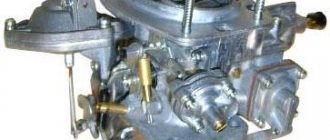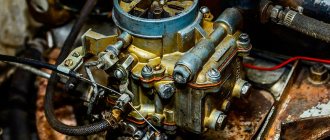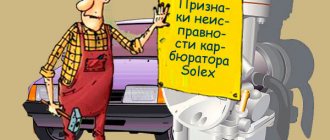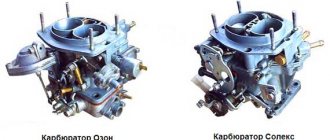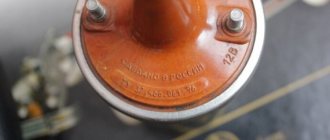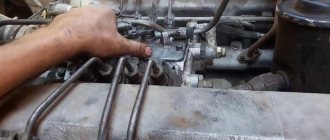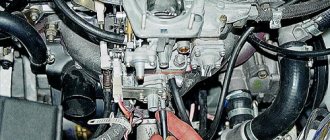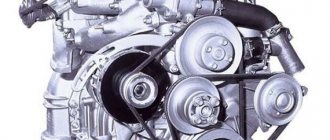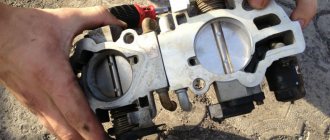Instead of a preface...
- What’s the problem? - Yes, I started eating a lot! I was driving from the south, refueled at some gas station, there was a strange sound and I started eating... - What kind of carb do you have? - Yes Dear. 151st. - It's clear. I'll see what I can do there...
From a client's conversation with me.
Expectations and reality
I open the cap on the loaf and reach into the carb. From afar I already understand that it was in vain that I bought a repair kit for the 151st carb ahead of time and without even looking...
There, on the manifold from an old single-chamber 131st carb, there is... DAAZ-4178
Well, it’s showing off - that’s to put it mildly... A piece of black shit, its indistinct outlines hinted at the fact that it was not the 151st at all. And not the 131st, either...
Its offal is no less shit-like.
And in general, the very fact of installing a two-chamber carb on a manifold from a single-chamber one is killing me!
Really, why isn’t he going? ...
OK. We need to clean it all out, wash it, blow it out and look at the inside.
I personally wash it with gasoline and carb wash. I use a small soft wire brush.
There are also a lot of surprises inside... Here they are.
The elephant is similar to the Nivovsky one. Jets from the bulldozer. Not a single jet in the factory range... Some obvious carburetor guru was working on the project...
Well damn, it makes sense to change the jets. Eat! But at the same time, not only the amount of gasoline passing through the nozzles changes, but also... AIR! The carburetor is an infection, such a “Gasoline-Air” system. There you can’t just change the nozzle rating and that’s it... The elephant in the first chamber wastes one and a half times more gasoline than is calculated... Well, there is such a trick. You can enrich the mixture a little. In order to give the drag a more complete combustion in the combustion chamber. A LITTLE! Second camera, what the hell? Well, if it’s not needed, then why install a two-chamber carb? Oh damn…
In short, I changed all the jets to the original values. I installed my own elephant. In both cells, little elephant. I set up the stream from the elephant as expected. I really couldn’t find the correct jet for the EPHH valve. It’s better there from the range from 48 to 52. I installed it from the repair kit at 41. I generally stood at 40... It’s kind of badass...
Replaced all diaphragms and gaskets. I cleaned and blew out all the channels. Reassembled. Started it up. I checked the air leak by covering the air intake with my palm. It stalls. So everything is in vain.
The modified DAAZ 4178 carburetor replaced the outdated K-151V, which was installed on UAZ vehicles. The product is manufactured at the Dimitrovgrad Automotive Assembly Plant.
In accordance with the technical characteristics provided, it has a number of advantages over its predecessors. Namely: an increase in acceleration dynamics, a reduction in fuel consumption by 7 - 9%. In the combined cycle, the UAZ can consume no more than the “31st” Volga, about 11 - 12 l/100 km. In addition, every UAZ owner can independently install a new type of carburetor instead of the standard one. To re-equip, you will need a minimum of costs: a set of automotive tools, a new unit, an asbestos gasket for the seat of the exhaust manifold from a VOLGA car. The electrical connection diagram is subject to minor modification.
Below we will look at how to carry out the replacement on our own, what the sequence of actions is, using the example of a UAZ car.
UAZ carburetor design
The main purpose of the equipment, regardless of the brand and model, is high-quality and timely preparation of the combustible mixture for the power unit. The following components take part in this process:
- float chamber: the main task is to accumulate a set amount of fuel inside the tank for subsequent pumping it into the cylinders for ignition. The main element is a needle-type valve. This is a kind of oil product level regulator in the fuel chamber of the unit. If there is a shortage, it opens access; if there is an excess, the supply is blocked. Thus, a constant required level in the system is ensured;
- diffuser chamber: serves as a kind of compartment for mixing gasoline with oxygen. The fuel is supplied inside by atomization, while the air creates a vortex flow to begin the mixing process. A foamed substance is formed;
- jet: the task is to supply an exact portion, a dose of fuel inside the chamber. This is achieved due to the presence of a through hole inside the nozzle. For some technical devices this hole is larger, for others it is smaller. Depends on what level of fuel consumption needs to be achieved or what portion of oxygen needs to be consumed. Since there are not only fuel, but also air;
- throttle valve: responsible for supplying fuel online when you press the accelerator pedal with your foot. Accordingly, the deeper, the greater the injection and vice versa;
- air and fuel communication through channels ensure the delivery of what is needed to the specified places for prompt mixing of the mixture.
Design features of the 4178 carburetor
The fuel mixer with modification DAAZ 4178 has a younger brother with catalog index 1107040. The latest model has differences:
- the presence of two fuel chambers;
- mechanical drive for sequential opening and closing of dampers;
- system of mechanical suction of crankcase gases through the throttle valve channels;
- a modernized chamber with a float, ensuring stability of filling and pumping of fuel;
- a corrector was installed for the first time - an ignition system timing regulator;
- a gas flow recirculation system was introduced;
- The econostat has been modernized - equipment that allows high-quality enrichment of the mixture at peak engine power loads. Particularly important when driving off-road, sand, and mud. After all, the UAZ was created for such elements;
- trigger mechanism - ensuring the most complete start at negative external temperatures;
- economizer - serves to block the access of oxygen inside the combustion chambers when the power unit is turned off and the dampers are closed;
- The accelerator pump is perhaps the main element in every car, responsible for the timely response of the accelerator pedal when you press it. Many dynamic characteristics of the motor depend on the information content;
- an idle valve that ensures the power unit operates even at low crankshaft speeds.
Design and technical characteristics of K-126GU
The K-126GU two-chamber carburetor with a falling flow of the fuel mixture is the basic model for UAZ vehicles. To set it up correctly, you need to have an understanding of the structure, parameters and operating principles of the unit.
- two working chambers for mixing fuel with dosing systems;
- economizer;
- accelerator pump;
- idle speed device.
To properly configure the K-126GU carburetor, you need to know about the structure, parameters and principles of operation of the unit
The unit allows uninterrupted operation in all possible modes. It is worth noting that the K-126 has a simple and reliable design. When properly configured, it provides fuel consumption per 100 km:
- for urban conditions 13 l;
- on the highway 11 l.
Carburetor adjustment
The procedure for setting up the unit is identical for most of this type of product. The fuel quality and quantity screw is used. If the settings are incorrect, the vehicle cannot function properly and operation is not recommended.
The adjustment algorithm looks like this:
- the power unit warms up to the minimum required temperature of 40℃;
- The quality screw is initially completely turned out with a screwdriver until it stops. After which it is screwed in 2 - 3 turns;
- with the second quantity screw, the tachometer speed is brought to 900 rpm;
- Steps No. 2 and 3 are repeated again until the speed is completely stabilized.
Carburetor tuning is successful if the transition from speed up to full reset is as smooth as possible when you press the accelerator pedal, there are no dips. If this is not observed, then you need to slightly tighten the quality screw upward.
Note to the driver: any malfunction in the carburetor is determined by the stability of the crankshaft rotation at idle. If the beats are uneven, there is a delay or advance, preventive maintenance of the unit is necessary. If you do not have the proper experience, use the services of a service center or service station to carry out repairs. The car should not be operated without diagnostics.
Transmission
The transmission of the UAZ-220695-04 vehicle consists of the following elements: clutch, gearbox, transfer case, cardan transmission, drive axles.
Clutch - manufactured by ZMZ, diaphragm, dry friction, with torsional vibration damper. The clutch mechanism is bolted to the engine flywheel, balanced together with the crankshaft, and its position after balancing is marked on the housing and flywheel with an “O” sign.
The gearbox is a five-speed manual, currently sourced from Chinese manufacturer BAIC. The quality of work of this “mechanics” often causes complaints from owners and drivers of new “loaf” minibuses. Previously, minibuses of the UAZ-2206 family were equipped with a domestic mechanical four-speed ADS gearbox, equipped with inertial-type synchronizers.
The transfer case is two-stage, with the function of disabling the front axle drive. The transfer case distributes torque between the two drive axles of the machine. Also, an additional reduction gear in the transfer case provides, if necessary, an increase in traction on the drive wheels and doubles the gear range. Gear ratios – direct transmission: 1.00; reduction gear: 1.94.
Typical malfunctions of DAAZ 4178
Among the most common reasons is the unstable operation of the needle-type valve in the chamber. When fuel is supplied incorrectly, the portions are not the same. Excesses often lead to the fact that the power unit begins to choke from excess gasoline. The solution may be a partial repair, replacing the valve with a new one, or installing a non-standard valve with an increased diametrical clearance. However, to do this you will need to completely remove the carburetor from its standard seat.
To a lesser extent, the clogging of fuel supply channels due to the ingress of debris, dirt, and foreign objects, the location of which should not be a priori, “interferes” with full-fledged operation.
Basic faults
The presence of possible malfunctions in the carburetor on a UAZ car can be judged by the characteristic signs of the car’s behavior on the road. The most common cause of unstable carburetor operation is wear of parts or contamination of valves, internal surfaces and holes.
Almost all carburetor malfunctions can be detected when the UAZ engine is idling. If, with proper adjustment, the engine runs unstably, often stalls and has difficulty starting, then it’s time to disassemble and repair the carburetor.
The most common malfunction is wear of the needle valve in the float chamber. With this malfunction, excess fuel impairs engine idle performance. The solution to the problem may be to replace the valve. Various valves and holes tend to become clogged over time, which leads to a narrowing of the cross-sections of the channels and holes. To ensure that engine performance does not deteriorate, regular washing and cleaning of the carburetor is required. This procedure can only be done by completely disassembling the carburetor, otherwise you simply cannot get to all the valves and holes.
The operation of a carburetor engine has its own characteristics that should be taken into account. First of all, it should be understood that, unlike an injection engine, which is controlled electronically, a carburetor engine is controlled by the driver. Therefore, all worries about adjustments and settings fall on the shoulders of the car owner.
The most common causes of breakdowns of DAAZ 4178
- mechanical damage to the hull due to an accident, collision, impact. When the integrity is broken and the unit cannot actually fully perform the functions assigned to it;
- factor of defects during manufacturing in the factory. There are frequent cases when, instead of the proper material for the base, a low-quality product is used that does not meet the requirements and standards;
- poor quality of repair work carried out by previous service center technicians and amateurs;
- installation of non-original products in order to save money.
The above list is not exhaustive, but it is enough for the owner of a technical device to pay attention to the unstable operation of his car.
Sequence of actions for self-installation
As already mentioned at the beginning of the article, to replace a standard carburetor with a modernized one, you will need an asbestos gasket on the seat of the exhaust manifold from a VOLGA 2410 car. The absence of a gasket will complicate the work and will delay the process of installing the carburetor for a long time. Since the unit is structurally located in the engine compartment, all work will be carried out in the transport position of the vehicle.
- the technical device is installed on an inspection hole or a flat platform for easy access to the engine compartment from all sides;
- the hood is opened, the engine must cool to such a temperature that it is impossible to damage the skin during repair work;
- the standard housing part of the air filter is unscrewed along with the filter itself;
- the nuts are unscrewed from the studs, the previous (old) carburetor is removed;
- It is imperative to unscrew the stationary long studs from the exhaust manifold seat and screw in new, short ones in their place. If such a replacement is not made, then DAAZ 4178 1107010 will be impossible to physically install in its original place;
- the pneumatic valve is removed along with the body part;
- a relay-regulator is screwed into the vacant space;
- a new asbestos gasket is placed in place of fixation in the exhaust manifold;
- the fittings on the carburetor and the engine are connected using ordinary hoses;
- the electrical circuit of the circuit is connected in accordance with the distribution;
- the forced idle economizer must be connected to the power supply;
- The quality and quantity screws are adjusted.
The detailed fine-tuning procedure is described in this article slightly higher. You can use the recommendations to achieve the desired positive result.
In parallel with the installation of new equipment, carry out visual diagnostics of auxiliary elements and systems. There may be mechanisms that need emergency repair using repair kits.
Replacement of nodes takes place in this order:
- Removing the air filter.
- Dismantling the standard K-151V carburetor.
- Replacing the carburetor mounting studs with shorter ones.
- Dismantling the EPHH valve.
- Installation of an additional switching relay.
- Installation of gaskets and carburetor DAAZ-4178.
- Connecting the fittings of the ignition distributor and DAAZ-4178 using a hose.
- Installation check.
The DAAZ-4178 carburetor on the UAZ requires the use of an additional switching relay, which uses normally closed contacts. To simplify the circuit, +12 V voltage can be supplied to the EPH valve directly from the ignition switch.
Good day! At the moment, the UAZ (engine 421) has a 151E carburetor installed, the spark plugs constantly turn black, the engine starts to stall, and therefore does not run. Cleaning, washing and blowing did not help. I'm afraid to regulate, and I don't know. In the taiga at -40° this can end in disaster. The DAAZ 4178-1107010 carburetor has been in storage for a long time. I found instructions on the Internet for setting it up.
However, I couldn’t find exactly where these quality and quantity screws were. Help, friends! Show it in the photos!)) Photo 1
Photo 2
Photo 3
And the second question. How to connect the solenoid valve when switching from 151 carb to 4178?
The quantity screw is apparently the idle speed screw. The one that rests on the throttle lever. It regulates the degree of its closing. and the second will be the quality screw (adjusting the mixture according to the air-gasoline ratio).
I understand about the quantity screw. The second theory is clear, but you have to point your finger))
Specialists in carburetors are hard to find during the day now. So that they know each model. So, using scientific poking.)) I see that this is the one with red hair in the middle in the second photo. In the second photo on the right, just below, there is a quantity screw. Instead of an electric valve, you can simply try installing a plug with a broken plug needle. It will work more reliably.
Red one, this one?
This screw regulates the opening of the second chamber shutter.
the one immediately above the selected one is the quantity. I don’t know about the selected one.
quality screw - in the first photo at the bottom of the carb is inclined
It’s rightly said about the elval valve: bite off the needle and drive like that
So: quantity screw:
It regulates the degree of opening of the primary chamber damper (in short - idle speed) Quality screw:
So it confirmed my speculations and Google information))
From what I have researched, this valve should be constantly open. You supply +12 V. from the lock, turn on the ignition, the valve is open, turn off the ignition, the valve is closed. If so, then you can take the wire from 151 (original) carb (+12 V) and attach it to the electric. valve of the new (4178) carb. It turns out that the needle can actually be broken off and poured out like this, but for now let’s leave the drain.
I didn’t understand the angles. Well, since the one highlighted in the bottom photo does not go into the shutter lever, then yes, it is quite likely responsible for the quality.
The operation of this valve has two options: simply turn off the fuel supply when the ignition is turned off, in order to avoid glow ignition, as on the VAZ2106, in this case, of course, you need to leave the needle
and the second option, when this valve is part of the EPH system, that is, at certain speeds and loads it turns off the fuel supply. In this case, it is better to remove it, because the benefit is small, imperceptible, and the system is a lot of troublemakers.
Modifications and classifications of units
- 4178-1107010 30: adapter for the factory UAZ filter, a pre-installed hole in the damper to drain fuel when the permissible level in the accelerator pump is exceeded while the damper is closed. The diameter of the diffuser opening is smaller than on the “40” model;
- 4178-1107010 40: an adapter is installed for the metal air filter housing on 3302, there is a return line and a gas cable, unlike the previous gas cables. The accelerator pump cam has a modified shape, unlike the “30” model;
- 4178-1107010 40 is installed on the UAZ model with the UMZ 421 power unit with a volume of 2.9 liters;
- 4178-1107010 30 is installed on new modifications of GAZelles with ZMZ engines with a volume of 2.5 liters.
- 4178-1107010 - a classic version of the UAZ with the UMZ-4178.10 engine.
In all other respects, the units are completely identical, as are their settings. You can buy the unit at the automobile market or auto store. Regardless of the form of choice, you must be extremely careful. Choose only high-quality and original products, carefully review the technical characteristics of the carburetor in the operating instructions.
Maintenance tips and tricks
The main enemy of every mixer, regardless of brand and modification, is low-quality and dirty fuel with which the system is filled. Systematic clogging makes it difficult for gasoline to flow through the channels; the engine is forced to expend more effort and power to overcome the barrier and deliver fuel to its destination. Therefore, before uploading, make sure the quality of the content.
Do not fill the tank with various types of chemical additives to restore the octane number or increase properties. Supplements have never brought any benefit, only harm. Chemical reagents corrode pipes, contribute to incomplete combustion of the combustible mixture, the formation of soot, excessive sulfur content, metal oxides, and a rapid decrease in fuel level. All of the above leads to premature wear of parts, failure of units, and sudden overhaul of the engine.
Review from the owner of a UAZ car with carburetor 4178-1107010
Oleg , 37 years old, owner of a UAZ, private entrepreneur. By the nature of my activity I am engaged in trade. You have to purchase products in different places and geographical areas: snow, frost, ice, rain, and other bad weather. The old, standard carburetor often lacked the power and agility to make a breakthrough at the right moment. And I ate “good” fuel. On the recommendation of friends, I installed the “40th” for myself, there are no limits to my joy. The car is playful, the accelerator pedal is responsive, gasoline consumption has decreased by 10%. They say that you can install other modifications of the DAAZ on the UAZ, but it is necessary to redo a lot of factory fasteners. I won't take any risks. This is quite enough. I recommend to all.
Installation
Installing the unit is easy. Even a novice car enthusiast can handle it.
Sequencing:
- We remove the standard device;
- We change the mounting studs in the manifold (shorter ones are required);
- We dismantle the energy-pneumatic valve (in its place we install a switching relay);
- We install gaskets (thin, then thick). If not installed, the pump drive may be damaged;
- We install DAAZ-4178;
- We connect the fittings of the unit and the ignition distributor with a hose;
- We lay out a new electrical circuit for economizer control (EPCH);
Even a novice car enthusiast can cope with installing the DAAZ-4178 on a UAZ
How does a carburetor work?
The operation scheme is extremely simple: fuel is supplied to the float chamber through a needle valve, which is rigidly fixed to the float. The main fuel jets are installed at the bottom of the chamber, from where it flows through channels to the diffuser. Due to the vacuum created in the engine cylinders, air under pressure penetrates through the diffuser and mixes with gasoline, which is split by means of a spray. Next, the mixture goes into the intake manifold, after which it goes into the cylinders.
When the amount of gasoline in the float chamber decreases, the needle valve opens and allows a new portion of gasoline to pass through. After filling, the chamber is locked again and the process is repeated throughout the entire operation of the engine equipped with a carburetor. To create atmospheric pressure, air is removed from the chamber using a special channel connected to the top of the diffuser. Thanks to this, the camera is balanced.
Carburetor DAAZ 4178 float chamber device
The carburetor is designed to prepare a fuel-air combustible mixture with its further supply to the engine cylinders. The simplest carburetor consists of only three structural elements - a float chamber, a diffuser and a metering system.
- Float
- Jets
- Needle valve
- Balancing channel
Carburetor adjustment 1111-1107010
Main dosing elements and adjustments:
Name
2 camera
↑
Carburetor adjustment 4178-1107010
Main dosing elements and adjustments:
| Unit | 1 camera | |||
| Mixing chamber diameter | mm | 28 | 36 | |
| Large diffuser diameter | mm | 20 | 25 | |
| Small diffuser spray | Marking | 3 5 | 4.5 | |
| Idle fuel jet | Marking | 41 ±3 | ||
| Transition system fuel jet | Marking | 50 | ||
| Main fuel jet | Marking | 95 | ||
| Emulsion tube | Marking | 11 190 | 11 95 | |
| Acceleration pump nozzle | Marking | 40 | 35 | |
| Needle valve | Marking | 16 | ||
| Throttle starting gap | mm | 0.7-0,8 | ||
| Air damper starting gap | mm | 2.0 — 2,4 | ||
| Fuel level | mm | 22-24 | ||
| Name | Unit | 1 camera | 2 camera |
| Mixing chamber diameter | mm | 28 | 36 |
| Large diffuser diameter | mm | 24 | 26 |
| Small diffuser - atomizer | Marking | 4 | 4 |
| Idle fuel jet | Marking | 41±3 | |
| Transition system fuel jet | Marking | 60 | |
| Main fuel jet | Marking | 115 | 122,5 |
| Emulsion tube | Marking | A 125 | ZC 125 |
| Acceleration pump nozzle | Marking | 45 | 35 |
| Needle valve | Marking | 2,1 | |
| Throttle starting gap | mm | 1,3-1,4 | |
| Air damper starting gap | mm | 6,4-6,8 | |
| Fuel level |
↑
Carburetor adjustment 4178-1107010-30
Main dosing elements and adjustments:
Name
2 camera
↑
Carburetor adjustment 4178-1107010-40
Main dosing elements and adjustments:
| Unit | 1 camera | ||
| Mixing chamber diameter | mm | 32 | 36 |
| Large diffuser diameter | mm | 24 | 26 |
| Small diffuser - atomizer | Marking | 4 | |
| Idle fuel jet | Marking | 48 ±3 | |
| Transition system fuel jet | Marking | 60 | |
| Main fuel jet | Marking | 120 | 120 |
| Emulsion tube | Marking | 11 190 | ZC95 |
| Acceleration pump nozzle | Marking | 60 | |
| Needle valve | Marking | 2,1 | |
| Throttle starting gap | mm | 1,4-1,5 | |
| Air damper starting gap | mm | 6,8-7,2 | |
| Fuel level | mm | 12 — 24 |
| Name | Unit | 1 camera | 2 camera |
| Mixing chamber diameter | mm | 32 | 36 |
| Large diffuser diameter | mm | 26 | |
| Small diffuser atomizer | Marking | 4,5 | 4,5 |
| Idle fuel jet | marking | 50-44 | |
| Transition system fuel jet | Marking | 60 | |
| Main fuel jet | Marking | 122,5 | 120 |
| Emulsion tube | Marking | A 180 | ZC 130 |
| Acceleration pump nozzle | Marking | 45 | |
| Needle valve | Marking | 2,1 | |
| Throttle starting gap | mm | 1,3-1,4 | |
| Air damper starting gap | mm | 6,4 — 6,8 | |
| Fuel level | mm | 22-24 |
↑
DAAZ carburetor throttle valve
To adjust the mixture composition in different operating modes, a throttle valve control drive is provided, which is connected to an additional fuel supply system during driving. When you press the accelerator pedal, it opens and an additional portion of gasoline is supplied to the diffuser. This mechanism is called an accelerator pump. It ensures responsive operation of the accelerator during sudden acceleration of the car, in order to prevent the mixture from becoming lean.
Facilitation of starting in cold weather is provided by the air damper, which closes and limits the air supply, increasing the amount of fuel in the cylinders. The drive is controlled using a cable, which is led into the UAZ interior via a handle.
Returns and exchanges
RETURN OF PRODUCT OF PROPER QUALITY You have the right to refuse the ordered product at any time before receiving it, and after receiving the product - within 7 calendar days, not counting the day of purchase, with the exception of goods that cannot be returned.
Return of a product of proper quality is possible if its presentation, consumer properties, as well as a document confirming the fact and conditions of purchase of the specified Product are preserved. The product must not show signs of installation, damage, chips, dents, scratches, etc.
If we refuse the goods, we return the cost of the returned goods, with the exception of costs associated with the delivery of the goods returned by the Buyer, within 10 calendar days from the date of receipt of a written application for return. An application is considered submitted in proper form if it is in writing and signed by the buyer. The return application is submitted simultaneously with the product you are refusing.
Economizer (EPHH)
To save fuel, EPHH is used, which in Solex carburetors acts as a solenoid valve. A special feature of the device is that when the speed drops below 1000 rpm, it starts working and prevents the engine from stopping, reducing the emission of toxic substances into the atmosphere. The economizer turns on the idle jet after the ignition is turned on. When removed from the power supply, the valve remains closed constantly. The valve is always open regardless of the engine operating characteristics. When working on the transition system, the fuel goes into the throttle space, and at this moment the XX jet closes.
The DAAZ 4178 carburetor is a two-chamber carburetor with a balanced float chamber and has an air bleed system to adjust the operation of the octane corrector, which allows the use of gasoline with different octane numbers. Such technical characteristics are progressive.
Very often, a carburetor may come out under the name “Solex”, which is French. Russian designers bought a license to produce these carburetors when front-wheel drive VAZ cars began to appear on the assembly line. The Solex design is one of the most reliable and allows you to save a large amount of fuel.
Conclusion
We talked about how to set up a DAAZ-4178 carburetor on a UAZ. As you can see from the description, there is nothing complicated. Conduct setup and maintenance of the unit in a timely manner and the “good old” DAAZ-4178 will never let you down.
Perhaps you have experience installing and adjusting a carburetor on an UAZ? Share your knowledge with our readers in the comments. Any information would be very helpful.
Driver's tool set
Moreover, the “freezing” glitch began to progress in it. It manifested itself like this: in 3rd or 4th gear we sharply press the gas, the car “thinks” for a while and stalls wildly, and only then begins to accelerate. Adjusting the accelerator pump tongue and adjusting its drain needle softened but did not eliminate this defect. And one fine autumn day I decided to file for divorce from him. Because this couldn’t go on any longer, my patience ran out. But somehow it’s impossible to drive without a carburetor at all, so I had to look for a new one. NOT K-151V!! Combing the Internet and stores showed 3 real ways to develop this topic. These are K-126GU, DAAZ-4178 and Solex, adapted for GAZ-3302. The first carb is simple and reliable. Reviews about it are only positive. It is quite expensive, about 1700-1900 rubles. (hereinafter the prices are 2006), but, as I understand, this money is justified. But, honestly, I didn’t want to get involved again with the products of Lenkar (now Pekar). Secondly, I don’t really like museum exhibits in real life. Agree - K-126 is already outdated. Yes, this piece of hardware with holes works, works, and works again. And yet I didn’t want him. That's why I put K-126 in last third place. If nothing else worked out, I would return to him. Second on my list was DAAZ-4178. The thing is rarer than the 126th. It is a modified carb from OKI, only with GTZh and GVZh greater throughput and the carb itself is adapted for UAZ. Several nuances immediately catch your eye: the float chamber needle is located in the carb cover, above the float. DAAZ also does not have a quantity screw. Its function is performed by the stop screw of the throttle valve of the first chamber. The diffuser of the first chamber itself is much smaller than that of the K-151V, but the diffuser of the second chamber, on the contrary, is larger in diameter than that of the K-151V. Two accelerator pump nozzles - in the first and second chambers. Why the second one is needed is not clear to me. Everyone usually turns it off. He still “pees” into the closed valve. The DAAZ-4178 costs about 1,700 rubles, which is quite affordable. There are few reviews, but they are positive. There are several disadvantages, such as complexity, few spare parts and in off-road problems with the locking needle, because the carb is sensitive to the position of the car. With strong rolls, the needle opens spontaneously. Well, the third was Solex. He was actively promoted on UAZBuk by a certain “Pavlik”. It was so advertised that I already mentally bought it. Simple, easy to find, rational design. Solex was purchased from the French when front-wheel drive VAZs were being prepared for production. The only negative is that the Solex needs to be adjusted to the UAZ. The version for M-2141 or VAZ-21213 is most suitable for this. But, in principle, you can use any. All cases are the same. In addition to adjusting the body (we go through the original holes with a 10 drill), it was necessary to select the jets. There are approximate sizes of new ones on the Internet. But I didn't want to deal with fitting a new carb. I played enough with the K-151B until it was brutal. Therefore, I purposefully looked for a rare type - a Solex on a Gazelle. It is already selected specifically for 402 (or 410?) engines. And I found it! But when I saw the price, I realized that the Solex was not for me. 3000 rub. for bare carb. Cool! Alas, I don’t want to pay that kind of money for a Solex. That's why I bought it. DAAZ-4178. ABOUT! I can already hear 54mm adjustable wrenches, shovels and everything that was heavy at hand flying at me. But I will repeat once again - well, I DO NOT WANT the classics of the K-126GU genre. Well, I don’t like him and that’s all! Why should we only go the traditional route? I decided to try something new. There were no problems installing the DAAZ. Everything is easy and not forced. I liked it even in the store - there are no burrs (anywhere!), very soft and jam-free operation of both throttle valves (my K-151V opened the second chamber with a creak and nothing helped). Well-thought-out suction mechanism. In general, it’s just a fairy tale. There are no words. True, after installation, I had to move the return spring higher on the gas pedal. The 4178 has a very soft native spring on the primary chamber damper, the pedal simply becomes weightless! The carb required almost no adjustments. I adjusted the XX a little and drove off. Everything else was normal. All screws and jets were tight and the fuel level was perfect. Let's go! Super! But I only drove about 10 km. There was no need for more. How I had a blast while driving! No failures at all! A little throttle and we took off. The engine has become very flexible. Noticeable pickup at all speeds. As a result, I sit and have fun!! Yes, ATE-2 with a more powerful spark also played a role here. But carb is good too! The only negative that I identified is that engine braking has become worse. With the gas released, the car rolls much further. It's good in summer, but in winter it will be a problem. You will have to press the brake more often. I think the smaller diffuser is the main “culprit” of these changes. In it, the flow rate is higher, and there is a better displacement of gasoline vapors with air. As a result, the mixture is more even in composition. Which burns better. Like this! DAAZ-4178 is a good carb. I will test it further. 10km is not a long time. These were just first impressions.
Part 2 Well, I’ve already driven about 300 km on asphalt with a DAAZ carb. During this time, I have accumulated something, which I am sharing. As I already wrote, the first serious trouble that happened after installing the DAAZ was the formation of a large amount of soot on the spark plugs. When this began to appear (the carb had factory characteristics), I obviously tightened the quality screw, thinking that I was thereby leaning the mixture. I thought wrong! After my intervention, driving became completely impossible. The threads and the central electrode began to become covered with loose black soot. Okay, I figured out the quality screw - I released it, and the mixture returned to normal. To check, I screwed in one clean spark plug, started it and let it run for XX 40 minutes. Then I turned the candle out - it was clean, with a little light brown residue. This is fine. I wrapped up the cleaned old one and decided to do a short test drive. And then it began! The old song is that you press the gas sharply and the engine tries to stall. As it was on K-151, one to one! Then I enriched the mixture again - the glitch disappeared. But the candles began to work intermittently again. It's a vicious circle. In cases of failure when the throttles are opened sharply, the accelerator pump is to blame. On the K-151, the UN drive is initially unviable due to backlash, but in the DAAZ there is no such “bugs”. All parts of the UN are firmly planted there. I remove the carb cover, begin to open the valves, pulling the drive with my hand, while looking at the UN stream. The spray jet looking into chamber 2 is normal: thin, hits the center of the throttle valve, and does not touch the walls of the diffuser. But the stream from the sprayer of the 1st chamber was difficult to call a stream. When the first damper was sharply opened at stroke 13, a large drop of gasoline appeared at the tip of the nozzle. She, hanging a little on the spray tube, reluctantly fell down onto the damper. Hmmm, with such “pressure” the failures are obvious. In order to increase the pressure in the 1st chamber, I decided to turn off the sprayer of the 2nd chamber. Still, the shutter of the 2nd chamber is closed. By clogging the nozzle hole with pliers, I thereby slightly increased the pressure into the 1st chamber. I start it, accelerate it - no positive effect from my actions. BUT! Now the failure began to be observed when opening the 2nd chamber. And a sharp failure. In general, a sprayer in the second chamber of the DAAZ carburetor is simply a MUST! It complements the system of transition from 1st camera to both. I'm going to the store, or rather, trudge. Because I sharply press the gas - the car stalls. I am buying a DAAZ repair kit for OKI. I take the new atomizer out of the box, disassemble my carb right in the parking lot, and remove the original one. What I see is that on the original atomizer, the spout looking into the first chamber (which created the problems) ends with a hole with a diameter of about 0.7 mm. And while the spout of the purchased sprayer ends with a calibrated hole, into which even the tip of the needle does not fit. I install a new sprayer and sharply open the shutter of the 1st chamber by a third. As soon as I began to open the damper slightly, a smooth, thin stream appeared from the sprayer, directed towards the center of the damper. I collect it and start it. I accelerate - and, lo and behold, NO FAILURES! Everything fell into place. Everything works as expected. Now I sit and think what it was. Manufacturing defects? More likely. The sprayer was initially defective and did not work. The second defective thing in my DAAZ was the EPHH valve. It initially did not work, there is tension, there is no tension - its needle remained motionless. This defect was not terrible, since the needle “stuck” in the “open” position and did not interfere with work. To begin with, I simply cut it off with side cutters, just in case. But then I got the idea to use this valve for its intended purpose, that is, to turn off the engine. To do this, I purchased a valve (she and Oka have the same valve) and powered it to the 3Z. More precisely, to the standard fuse, which is de-energized after the ignition is turned off. I start it up, remove the wire from the valve, and the engine stalls! The system works, the valve closes the XX fuel jet. Now when I turn off the ignition the engine immediately stops running. Previously, the engine could wobble for another 15 seconds after turning the key. Especially hot, the mixture spontaneously ignited from the hot electrode of the spark plug, such as glow ignition. And now this defect is gone!! Everything is clear - I turned the key, the engine stalled. And it doesn’t matter what the temperature is in the cylinders. I carry the old valve with me in case the new one suddenly fails. Well, my last intervention in the carb was a new shut-off needle for the float chamber. On UAZbuk they wrote that there are no UNIKAR locking needles on DAAZ type “OKA” (DAAZ-4178, DAAZ-1111). However, while looking at a store display dedicated to Oka, I came across a UNIKAR needle for DAAZ. Costs 35 rubles. Of course, I bought it. I came home and went to the UNICAR website to make sure that such a needle exists in nature. And indeed there is! I installed it and the fuel level is normal. Works fine. I didn’t have any questions about the standard needle, I just wanted to check the UNIKAR product. Like a super-duper correct new cone that provides a reliable seal, with this needle there is no need to adjust the fuel level during operation (this is definitely nonsense!), the technology is patented, etc. UNIKAR needles are available for all types of Russian carbs, incl. and for the 126th. In conclusion, I am very pleased with the DAAZ, apart from the 2 factory flaws listed above, there were no more problems. I’m still in awe of the new agility of my UAZ.
Carburetor Application
DAAZ 4178 found its application on various Soviet-made cars. Initially, it was designed for the UAZ, but due to the similar structure of the engines, it is perfect for both the Volga and the Gazelle.
Through minor alterations and upgrades, the carburetor can be adapted to almost any other car with your own hands, improving the technical characteristics. Its main area of application is engines with a volume of 1.5 liters or more, where a large amount of air-fuel mixture is required. This device allows you to easily move a heavy car from a place with minimal gasoline consumption.
Gradually, the use of carburetors fades into the background. Now they have been completely replaced by the fuel injection system. Their operating scheme is more complex and reliable. But there are still a huge number of lovers of carburetor engines in the world, thanks to the possibility of self-tuning and the high ability to carry out repairs even in the field. Carburetors still remain popular on Russian cars. And the Dimitrovgrad plant still produces carburetors for various Russian-made cars.
A little history
In the wide open spaces of Russia, you can still often find Soviet SUVs of the UAZ 469, 469B and 469BG models (military, civilian and medical, respectively), the production of which began back in 1972. They are the predecessors of the current UAZ 31512 and 31514 models, which appeared as a result of modernization in 1985, which are still successfully serving today. In the same way, the onboard UAZ 452D in 1985 became the UAZ 3303.
The UAZ 469 model had a standard single-chamber K 131 carburetor, which is currently morally and physically outdated (it is practically impossible to find it in good condition). Subsequently, with the advent of newer engines, the K 126 carburetor appeared, and the UAZ 31512 and 31514 models received the new PeCar K 151, which is equipped with many other Russian-made cars (Volga, GAZelle, Sobol, and so on). All of the above carburetors were produced by the Leningrad Carburetor Plant. Our task is to consider the possibility of replacing them with units from another manufacturer (DAAZ).
Brief overview of carburetor models
Here is an overview of the models of units produced by DAAZ, suitable for installation on Ulyanovsk SUVs.
- DAAZ 2101/02/03 WEBER. It is impossible not to mention this predecessor of OZON carburetors, which works wonderfully with UMZ engines with a displacement of 2.4 liters installed on the UAZ 31512. WEBER is not as economical as its newer Dimitrovgrad counterparts, but in terms of traction characteristics it produces excellent results. Fuel consumption is slightly lower compared to K 131 or K 126. The disadvantage of the unit is that it is difficult to find in working condition. Typically, you need to find two or three old Webers to assemble one working one.
- DAAZ 2107 OZONE. A very suitable option for those who do not care about overclocking dynamics. Fuel consumption on the UAZ 31512 model after installing the 2107 carburetor is noticeably reduced. We deliberately ignore the second modification of OZONE - DAAZ 2105, which is designed for a much smaller engine displacement.
- DAAZ 2140 OZONE is an analogue of 2107 with a different set of jets and a less successful idle system. Suitable for installation if you already have it in stock, but if not, it’s better to purchase 2107.
- DAAZ 2108 SOLEX, DAAZ 21073 SOLEX. The first is designed for VAZ cars of the eighth and ninth families, the second is installed on the VAZ 21213 Niva. Solex carburetors are complex and high-tech products; their installation on the UAZ 31512 is completely justified, as it gives good results. Preference should be given to modification 21073, which has larger diffuser sizes. Both modifications are equipped with EPHH with electronics, so when installed on older machines, some modification will be required to connect it. In other cases, the electronic system is simply discarded, but this affects the efficiency of the car.
- DAAZ 4178 SOLEX. Among the carburetors of the Dimitrovgrad plant, it is the most adapted for UAZ cars; it is perfect for both the UAZ 31512 and UAZ 3303 models. It can also be installed on older cars (before 1985). Reliable, economical, easy to install, and has the largest number of positive reviews from admirers of the brand.
Differences from the K151 carburetor
DAAZ 4178 is a more progressive model. Unlike the outdated K 151, it has a higher quality design and is easy to adjust. An outdated carburetor, over time, loses its ability to adjust and allows failures when working with the accelerator pedal. The description of this phenomenon can be characterized as symptoms of a malfunction.
During its development, many shortcomings of previous models were taken into account:
- Smooth throttle operation
- A second camera has appeared
The DAAZ 4178 fastenings have also been improved. The gaskets are made of higher quality materials, which ensures a tight fit and eliminates the phenomenon of “air leaks”. Moreover, the carburetor now easily fits into its seats, which was not the case with its predecessor, which created a lot of problems both during installation and dismantling.
The main progressive device of the DAAZ is the appearance of a mixture quality screw, which allows you to adjust the ratio of fuel and air. As the screw rotates, the mixture can become leaner or richer, which is very important when setting up the unit. In the K151 there was no such possibility, and instead there was a screw for adjusting the position of the damper, which only regulated the amount of air supplied.
The dimensions of both carburetors are approximately the same. Therefore, the question of their interchangeability disappears.
How to adjust the level of the DAAZ 4178 float chamber with your own hands?
The float chamber is the main element whose parameters affect fuel consumption. The level in it must be maintained structurally and should not exceed 27.5 mm.
Adjusting the level of the float chamber of the DAAZ 4178: 1 - carburetor cover; 2 — float; 3 — float tongue; 4 - needle valve.
To gain access to the camera, you need to do the following:
- Remove the air filter
- Disconnect the damper drive
- Unscrew the mounting holes of the top cover
To check it, you need to start the engine and then turn it off. After this, you need to remove the top carburetor cover and measure the fuel level. If it is different, it is necessary to bend the float rods in the desired direction. Next, you need to reassemble everything and start the engine again. Further testing and installation is performed in the same way.
If the camera does not work correctly, it will need to be repaired. To do this, purchase a repair kit, which includes a float and a needle valve. It often happens that it jams, so it is better to replace it immediately.
Messages [1 to 25 of 76]
1 Topic from Hi Com 09/27/2012 09:59:55
- Hi Com
- Participant
- Inactive
- From: Krasnodar
- Registered: 28.09.2009
- Messages: 9284
- User Karma: -1
Topic: Setting up the DAAZ carburetor for different UAZ engines.
I made it for myself - I'm happy.
At the request of forum members, who quite often contact me in a personal message with various questions regarding the restoration of the DAAZ 4178 carburetors they own, in this post I will try to bring together all the information about the necessary modifications that will allow you to enjoy the use of the above-mentioned fuel metering devices. The experience of these alterations has been accumulated for a long time and not easily, and the necessary information is scattered across dozens and hundreds of pages of this topic, so it is quite difficult for people who have recently come to the forum and have not followed their appearance in real time to put them together. Although, in my opinion, independently collecting this information allows you to get acquainted with the nuances that, of course, will not be included in the following summary.
So, THE RECIPE FOR PREPARING ALL 3 MODELS OF DAAZ 4178 CARBURETORS FOR UMZ ENGINES with V = 2.5 l
How to adjust the position of the air damper carburetor DAAZ 4178 1107010?
The next step in adjusting any carburetor is adjusting the air damper. Approximately, in all cars its operating principle is the same. This is necessary for it to work correctly. If set incorrectly, it may not open or close completely, and the size of the slots greatly affects the operation of the motor. If cracks still remain, then it is necessary to carry out repairs by turning the adjacent walls. A description of the procedure can be found on any amateur website.
To set its position, before starting the engine, you need to loosen the cable and completely close the air damper. Pull out the starter handle completely and tighten the cable in this position. Now check the operation of the drive. It should work so that when the handle is fully extended, the damper is closed tightly, and when opening it does not jam and opens completely. After this, you can begin to adjust the idle speed of the carburetor.
Setting the idle speed of the DAAZ 4178 carburetor on a UAZ
The adjustment here is made in the same way as on the Solex. Therefore, the instructions will be relevant for both carburetors. Before starting the procedures, you need to set the ignition system and adjust the clearances in the valve mechanism. Their sizes must be nominal. The engine must be warmed up to the nominal temperature, otherwise all the work will be done incorrectly.
Set the mixture quality screw to 3 turns and start the engine. The speed should be high. To reduce them, you need to reduce the amount of mixture using the second screw. Tighten it until the speed drops to 900 rpm. It is not at all necessary that the arrow be exactly at this level. Deviations of +-50 rpm are allowed.
Optimal speed XX: VAZ - 750-800
Optimal speed XX: GAZ - 850-950
Optimal speed XX: UAZ - 850-950
Next, you need to adjust the quality screw so that the speed becomes the maximum possible. The direction of rotation depends on the carburetor itself and many other conditions, therefore, it is impossible to say exactly how this should be done. After this, set the speed again to the nominal mode by turning the quantity screw. Then there are two adjustment options - tighten the quality screw until the unit begins to shake slightly, or continue the cycle until the rotation of the quality screw stops increasing speed. Both options work, but the second leads to a reduction in harmful emissions into the atmosphere and will significantly reduce fuel consumption.
Next, we check the operation of the system. While idling, press the gas pedal sharply. The speed should rise quickly, without dips, and the speed drop should always be to the nominal level. If this is not the case, then you need to slightly unscrew the mixture quality screw. Or repair the unit by replacing the screw.
This is how you can configure the DAAZ 4178 carburetor with your own hands on a UAZ car. We wish you good luck on the roads!
Communities › UAZ drivers › Blog › question, which carburetor is better for the 417 engine
A question has arisen between carburetors, which is better: Baker 151 or DaAZ for 4178. Anyone rummaging around, tell me.
Comments 64
to 126 g and Zhugulevsky diffuser,
Daaz 4178, only I changed the jets.
I installed different Solexes on 417. The first was from the eight, then from the five with eight jets. I pulled it out to 12 liters. I tried from the field, the best option. I don't understand other carburetors. Maybe I just haven't seen better.
I installed two DAAZ and 126 and there are no complaints about either, but the 126 is much simpler and reiontically capable on the road (tested)
What's the difference between daaz and baker? And then someone tells me that Daaz is much more economical
I didn’t have any difference in terms of savings, but in terms of repairs the 126 is much easier, everything can be done on your knee, in DAAZ it’s more difficult to do on the road
The main thing is that it’s new and not a fake, I had a DAAZ on the 402m, no complaints. There are a lot of gaps on any old one, it is very difficult to remove them, which is why troubles begin.
Adjusted and then adjusted baker 151 with normal ignition + GDP + fuel. Everything is interconnected…
By 126 I have had no solenoid valves for 15 years, everything is mechanical
Daaz 4178. This has not been a secret for a long time! It does not freeze, pulls well, is economical and there are no problems with starting. But the main thing is to regulate it well!
costs k151v in general we fly but began to mope when starting up and got sick of freezing in the area of the adjusting screws, bought a k126gu a long time ago, at first there was a problem with choosing fittings for the vacuum and fuel valves, I decided to install it.
I drove 151 and didn’t blow my mustache. Consumption 10 on the highway. all was good. But then dancing with a tambourine began, XX periodically moped, the craving slowly but surely disappeared. Everything was sorted out, everything that was possible was replaced and licked repeatedly. I was already thinking about the engine ((until a neighbor in the garage, a retired driver, noticed what I was fiddling with and didn’t tell me that out of the entire convoy in their garage, only one car with a 151 could drive, all the others were removed. Well, that’s my opinion strengthened after the experts shrugged their shoulders at the stand and could not do anything. This is not an isolated case, a friend of mine in a gazelle repeated my experience. Those who drive the 151, go for it, it’s good until it glitches, and don’t think that everyone who took it off armless)) he just hasn’t started to blow your mind yet and you’re lucky. In general, I switched to 126 (if I’m not mistaken, it was developed at BMW, even for Muscovites) and I think its popular name, Golden, is quite justified. I installed it and the car started to turn sideways, onto the second turn. I will definitely not return to 151 again, and even if you call me armless or stupid, I’m just a practical person and I love everything simple and reliable. I am far from alone in this opinion. You just often hear that if you haven’t figured out 151, then you’re just a handyman)) so be it, but I’ve been driving for 7 years now and I’m not getting anywhere, if I just improve something, but even a schoolchild can understand 126, nothing extra, as inspires confidence in this piece of hardware. There is a video on YouTube where it seems like DAAZ was chosen by specialists from 3x 126, 151 and DaAZ was tested and described. I am writing to them saying that you guys have embellished something, because everyone who understands knows that any of them will not worsen the engine’s performance. They agreed, but simply explained it as an advertisement for Daaz (they were instructed to sell them) and laughed together, but the discussions were closed after that.)) Each of these carurators will not be bad, if there are some individual deviations and defects. You know how 2 identical engines work differently. In general, drive what you have, if it works, and don’t rack your brains about which is better, they will not be inferior to each other, if only in maintainability.
